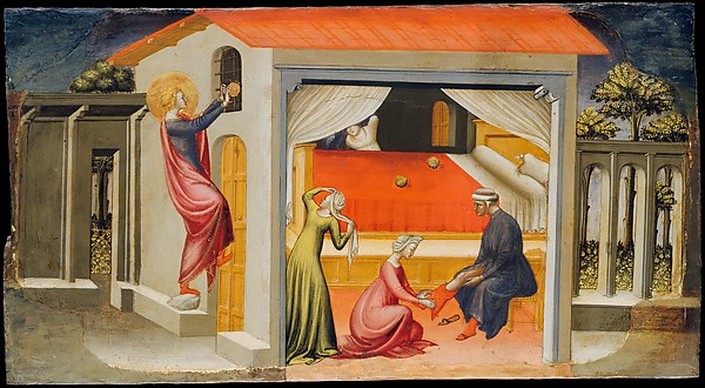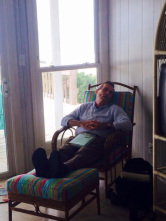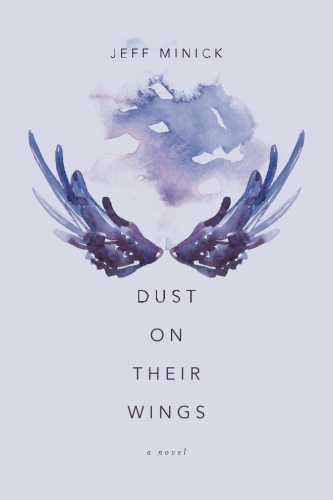“I suppose they try and make you believe an awful lot of nonsense?”
“Is it nonsense? I wish it were. It sometimes sounds terribly sensible to me.”
“But, my dear Sebastian, you can’t seriously believe it all.”
“Can’t I?
“I mean about Christmas and the star and the three kings and the ox and the ass.”
“Oh yes, I believe that. It’s a lovely idea.”
“But you can’t believe things because they’re a lovely idea.”
“But I do. That’s how I believe.”
Evelyn Waugh, Brideshead Revisited
At that time the disciples came to Jesus, saying, “Who is the greatest in the kingdom of heaven?” And calling to him a child, he put him in the midst of them, and said, “Truly, I say to you, unless you turn and become like children, you will never enter the kingdom of heaven.”
The Gospel of Matthew 18: 2-3
At Mass last Sunday, our priest proclaimed during an Advent homily that as Catholics we are required to believe in Santa Claus.
“Is it nonsense? I wish it were. It sometimes sounds terribly sensible to me.”
“But, my dear Sebastian, you can’t seriously believe it all.”
“Can’t I?
“I mean about Christmas and the star and the three kings and the ox and the ass.”
“Oh yes, I believe that. It’s a lovely idea.”
“But you can’t believe things because they’re a lovely idea.”
“But I do. That’s how I believe.”
Evelyn Waugh, Brideshead Revisited
At that time the disciples came to Jesus, saying, “Who is the greatest in the kingdom of heaven?” And calling to him a child, he put him in the midst of them, and said, “Truly, I say to you, unless you turn and become like children, you will never enter the kingdom of heaven.”
The Gospel of Matthew 18: 2-3
At Mass last Sunday, our priest proclaimed during an Advent homily that as Catholics we are required to believe in Santa Claus.
To some outsiders, the idea of a grown man declaring to a crowd of several hundred people the reality of Santa Claus may be disconcerting, indeed downright shocking. Some might think our priest had gone round the bend and up the river.
So let me explain.
When we Americans think of Santa Claus, we conjure up a pudgy guy with a white beard, dressed all in red and ermine trim, who drives a sleigh stuffed with toys and drawn by flying reindeer, a sort of eccentric uncle on a grand scale who makes his home with a motley crew of elves at the North Pole, who is more adept than the NSA and the FBI at ferreting out the naughty and the nice, and who, despite a girth built on cookies and milk, clambers down chimneys to deposit his gifts.
We forget, if we ever remembered, that this Santa Claus is the misbegotten and ill-conceived derivative of Saint Nicholas.
Saint Nicholas was a fourth century bishop in Myra, a city in present-day Turkey. He served time in the local hoosegow for his opposition to the Arian heresy, and was restored to his former post when Constantine became emperor. He helped devise the Nicene Creed, recited by Christians to this day, meaning that when we say the Creed we are repeating at least some of the ideas of Saint Nick. While at the Council of Nicaea, Nicholas also reportedly became so angry that he struck the heretic Arius in the face. There’s the real Santa Claus for you: a yard bird with a temper and a good solid punch.
Today Saint Nicholas remains a beloved figure, particularly in the Eastern Church. He is the patron saint of Moscow, Amsterdam, and Greece, and of sailors, repentant thieves, brewers, archers, merchants, children, pawnbrokers, and students. Artists East and West have reproduced his likeness in paintings and sculptures whose quantity is surpassed only by the Virgin Mary.
So how did we get Santa Claus from a guy who died over fifteen hundred years ago? And why are Catholics called to believe he lives?
Appearance first: Red was the color of the bishop’s robes and miter, which is a fancy name for a tall, pointed hat. Often these articles of clothing were trimmed with ermine. Bishops of certain eras in Church history also wore black sashes, hence Santa Claus’s black belt. Bishops in the East sported beards. Add these together, and we have a skinny Santa Claus.
Gifts: The bishop’s most famous deed was an act of charity. Having caught wind of a poor man unable to pay the wedding dowries for his three daughters—such a fate at that time might likely lead the young women into prostitution to try to raise such monies—Bishop Nicholas secretly delivered gold on three separate occasions to the father’s house, either through a window or down a chimney in a household too impoverished to afford firewood. The young ladies found husbands, and Saint Nicholas found ever-lasting fame in the hearts of men as well as a place in heaven.
Now the why: Because the Church has declared Nicholas a saint, and because we believe in a communion of saints—that is, the souls in heaven and on earth, and in the case of Catholics, in purgatory—Saint Nicholas is still very much among the living. We may not see him, but he is as real as Ralph the bartender’s red nose.
The Church commands us to believe in that reality.
But how are we to believe?
How, in fact, can we make sense of any of it: a virgin birth, a star in the East, angels singing to shepherds, a god-man walking among us, healing the sick and teaching a new way of living, that same god-man dying on a cross, leaving us with the wild idea that bread and wine blessed in a special way becomes His Body and Blood? After all, we are post-moderns, wanting like another doubter from long ago to thrust our fingers into the god-man’s wounds before we can believe.
The passages cited above give us the way to belief. Christ instructs us to have the faith of children, and Waugh's Sebastian Flyte, despite his manifold sins, demonstrates a species of that faith. Here we might note that Christ does not enjoin us to behave or think like children, but to have the faith of children. Saint Thomas Aquinas, one of the greatest of Christian philosophers and a prolific scribbler, said at the end of his life, “All that I have written seems like straw.”
Thomas Aquinas understood.
As for me, well it’s Christmas and if I am to become as a child, it’s time to ask Santa for a gift. The big gifts—world peace, universal brotherhood, a massive conversion of hearts—are beyond my ken and my merits, and I’d feel a fool asking for some trivial personal trinket.
But I do ask for your prayers, Saint Nicholas, your intercession for those of us who have sinned “in our thoughts and in our words, in what we have done and what we have left undone.” Pray for us and for a restoration of faith, hope, and love in all wounded hearts.
Thank you, Santa.
I’ll leave the milk and cookies in the usual place.
So let me explain.
When we Americans think of Santa Claus, we conjure up a pudgy guy with a white beard, dressed all in red and ermine trim, who drives a sleigh stuffed with toys and drawn by flying reindeer, a sort of eccentric uncle on a grand scale who makes his home with a motley crew of elves at the North Pole, who is more adept than the NSA and the FBI at ferreting out the naughty and the nice, and who, despite a girth built on cookies and milk, clambers down chimneys to deposit his gifts.
We forget, if we ever remembered, that this Santa Claus is the misbegotten and ill-conceived derivative of Saint Nicholas.
Saint Nicholas was a fourth century bishop in Myra, a city in present-day Turkey. He served time in the local hoosegow for his opposition to the Arian heresy, and was restored to his former post when Constantine became emperor. He helped devise the Nicene Creed, recited by Christians to this day, meaning that when we say the Creed we are repeating at least some of the ideas of Saint Nick. While at the Council of Nicaea, Nicholas also reportedly became so angry that he struck the heretic Arius in the face. There’s the real Santa Claus for you: a yard bird with a temper and a good solid punch.
Today Saint Nicholas remains a beloved figure, particularly in the Eastern Church. He is the patron saint of Moscow, Amsterdam, and Greece, and of sailors, repentant thieves, brewers, archers, merchants, children, pawnbrokers, and students. Artists East and West have reproduced his likeness in paintings and sculptures whose quantity is surpassed only by the Virgin Mary.
So how did we get Santa Claus from a guy who died over fifteen hundred years ago? And why are Catholics called to believe he lives?
Appearance first: Red was the color of the bishop’s robes and miter, which is a fancy name for a tall, pointed hat. Often these articles of clothing were trimmed with ermine. Bishops of certain eras in Church history also wore black sashes, hence Santa Claus’s black belt. Bishops in the East sported beards. Add these together, and we have a skinny Santa Claus.
Gifts: The bishop’s most famous deed was an act of charity. Having caught wind of a poor man unable to pay the wedding dowries for his three daughters—such a fate at that time might likely lead the young women into prostitution to try to raise such monies—Bishop Nicholas secretly delivered gold on three separate occasions to the father’s house, either through a window or down a chimney in a household too impoverished to afford firewood. The young ladies found husbands, and Saint Nicholas found ever-lasting fame in the hearts of men as well as a place in heaven.
Now the why: Because the Church has declared Nicholas a saint, and because we believe in a communion of saints—that is, the souls in heaven and on earth, and in the case of Catholics, in purgatory—Saint Nicholas is still very much among the living. We may not see him, but he is as real as Ralph the bartender’s red nose.
The Church commands us to believe in that reality.
But how are we to believe?
How, in fact, can we make sense of any of it: a virgin birth, a star in the East, angels singing to shepherds, a god-man walking among us, healing the sick and teaching a new way of living, that same god-man dying on a cross, leaving us with the wild idea that bread and wine blessed in a special way becomes His Body and Blood? After all, we are post-moderns, wanting like another doubter from long ago to thrust our fingers into the god-man’s wounds before we can believe.
The passages cited above give us the way to belief. Christ instructs us to have the faith of children, and Waugh's Sebastian Flyte, despite his manifold sins, demonstrates a species of that faith. Here we might note that Christ does not enjoin us to behave or think like children, but to have the faith of children. Saint Thomas Aquinas, one of the greatest of Christian philosophers and a prolific scribbler, said at the end of his life, “All that I have written seems like straw.”
Thomas Aquinas understood.
As for me, well it’s Christmas and if I am to become as a child, it’s time to ask Santa for a gift. The big gifts—world peace, universal brotherhood, a massive conversion of hearts—are beyond my ken and my merits, and I’d feel a fool asking for some trivial personal trinket.
But I do ask for your prayers, Saint Nicholas, your intercession for those of us who have sinned “in our thoughts and in our words, in what we have done and what we have left undone.” Pray for us and for a restoration of faith, hope, and love in all wounded hearts.
Thank you, Santa.
I’ll leave the milk and cookies in the usual place.






 RSS Feed
RSS Feed